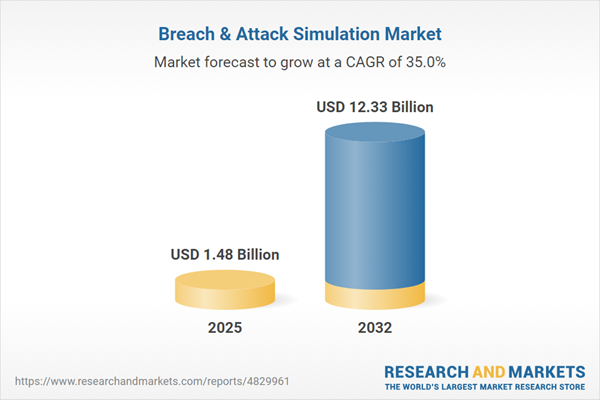Speak directly to the analyst to clarify any post sales queries you may have.
The breach and attack simulation market is transforming security strategies for enterprises seeking adaptive, data-driven defense across a dynamic digital environment. This report examines the drivers, challenges, and innovations shaping this evolving sector, enabling decision-makers to align priorities with real-world risks and business objectives.
Market Snapshot: Breach and Attack Simulation Market
The breach and attack simulation market grew from USD 1.11 billion in 2024 to USD 1.48 billion in 2025. Forecasts indicate continued growth, with a CAGR of 35.03%, reaching USD 12.33 billion by 2032. This momentum reflects increased demand for continuous security validation, proactive risk management, and the ability to mirror sophisticated cyber adversaries within enterprise environments. Adoption is broadening as organizations strive to benchmark controls, support regulatory compliance, and demonstrate resilience against complex threats.
Scope & Segmentation
- Component: Services such as deployment, support, and specialized training and consulting; Software encompassing automated threat simulation, compliance and reporting, continuous security testing, incident response simulation, and security controls validation.
- Security Type: Application security, endpoint security (desktop and mobile), and network security including data loss prevention and intrusion prevention.
- End User: Aerospace and defence, banking, financial services and insurance (BFSI), energy and utilities, government, healthcare, hospitality, and retail.
- Delivery Mode: Cloud-based, hybrid, and on-premises approaches that offer varying control and scalability options.
- Region: Americas (North America and Latin America), Europe, Middle East & Africa, Asia-Pacific, covering countries such as United States, Canada, United Kingdom, Germany, Japan, China, Australia, India, Brazil, South Africa, and more.
- Companies: Key market players include Acenture PLC, AttackIQ, Inc., Cymulate Ltd., SafeBreach Inc., XM Cyber Ltd., Fortinet, Inc., and others, each contributing to the sector’s technological advancement and adoption.
Key Takeaways for Senior Decision-Makers
- Automated simulations bridge the gap between static assessments and real adversary behaviors, empowering teams to validate security investments and prioritize remediation.
- Integration of artificial intelligence, cloud-native architectures, and IoT expansion are fundamentally altering both threat landscapes and simulation platform capabilities.
- Embedding breach and attack simulation into DevSecOps pipelines and software development lifecycles streamlines early vulnerability identification and drives security by design principles.
- Regional factors, such as advanced regulatory regimes in Europe and expanding digitalization in Asia-Pacific, impact solution adoption, with managed services helping to mitigate local resource gaps.
- Collaborations with managed security service providers and advances in microservices-based simulation offerings are supporting scalable, flexible deployment options.
- Executive oversight is essential, with simulation insights integrated into risk dashboards and continuous improvement initiatives, supporting resilience and accountability.
Tariff Impact on Supply Chains and Cybersecurity Investments
Upcoming United States tariffs are prompting organizations to evaluate procurement and budgetary strategies. Higher duties on hardware components drive cost reconsiderations, favoring vendors that offer local manufacturing or flexible, software-based solutions. Diversification of vendor portfolios is rising, while hybrid licensing models reduce capital pressures. These trends highlight the need to balance operational impact with long-term technology investment, ensuring continuity and adaptability under shifting trade policies.
Methodology & Data Sources
This analysis draws on a multi-stage approach that combines primary interviews with security professionals, secondary research from peer-reviewed and industry sources, and empirical validation through expert panels and focus group workshops. Consistency of findings is supported by cross-verification and iterative feedback to ensure both academic rigor and field relevance.
Why This Report Matters
- Provides actionable insights for board-level, risk-conscious leadership to align cybersecurity programs with evolving threats and regulatory expectations.
- Equips businesses to benchmark their defenses, prioritize investments, and guide procurement decisions amid economic and policy shifts.
- Highlights real-world applications across diverse verticals, helping senior stakeholders develop strategies that support growth, compliance, and resilience.
Conclusion
Breach and attack simulation is now integral to future-ready security architectures, driving a shift toward proactive risk management. With continuous innovation and growing adoption, organizations can enhance resilience and defend effectively against sophisticated cyber challenges.
Additional Product Information:
- Purchase of this report includes 1 year online access with quarterly updates.
- This report can be updated on request. Please contact our Customer Experience team using the Ask a Question widget on our website.
Table of Contents
3. Executive Summary
4. Market Overview
7. Cumulative Impact of Artificial Intelligence 2025
Companies Mentioned
The companies profiled in this Breach & Attack Simulation market report include:- Acenture PLC
- AttackIQ, Inc.
- Aujas Cybersecurity Limited by NSEIT Limited
- Broadcom Inc.
- Check Point Software Technologies Ltd
- Cronus Cyber Technology Ltd.
- CyCognito Ltd.
- Cymulate Ltd.
- Cytomate
- Detectify AB
- DXC Technology Company
- FireMon, LLC.
- Fortinet, Inc.
- International Business Machines Corporation
- IronSDN, Corp.
- Keysight Technologies, Inc.
- Mandiant By Google LLC
- Miercom
- NopSec, Inc.
- Pentera
- Picus Security, Inc.
- Proofpoint, Inc.
- Qualys, Inc.
- Rapid7, Inc.
- ReliaQuest
- SafeBreach Inc.
- SCYTHE Inc.
- Trellix by Musarubra US LLC
- XM Cyber Ltd.
Table Information
| Report Attribute | Details |
|---|---|
| No. of Pages | 190 |
| Published | November 2025 |
| Forecast Period | 2025 - 2032 |
| Estimated Market Value ( USD | $ 1.48 Billion |
| Forecasted Market Value ( USD | $ 12.33 Billion |
| Compound Annual Growth Rate | 35.0% |
| Regions Covered | Global |
| No. of Companies Mentioned | 30 |









